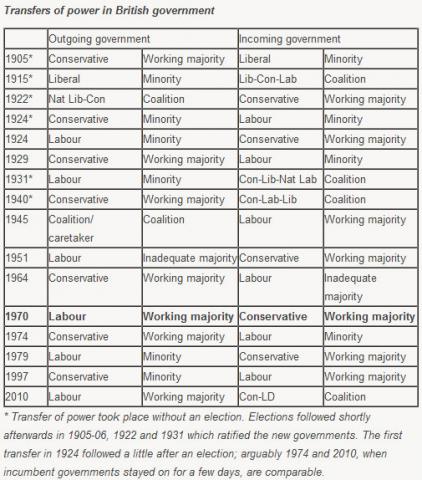Is First Past the Post good at throwing out unpopular governments?
"In just 1 election in 100 years has a government with a working majority been replaced by a government with a working majority from another party... because it's nigh on impossible for voters to 'kick the rascals out.' Under First Past the Post majority governments appear to stay in power until they die in office, until their majorities are worn down, or they're replaced by minority or coalition governments." 'Yes to fairer votes'.
"If you want a system that lets you, as the Americans say, 'throw the rascals out'...You must vote on May 5th, and you must vote No to AV." David Cameron.
According to supporters, First Past the Post is an electoral system whose strength lies in its ability to allow people kick out unpopular governments at election time.
This was also a conclusion made by the Jenkins Commission on electoral reform, which said that FPTP "enables the electorate sharply and cleanly to rid itself an unwanted government"
However advocates of change claim that this benefit of FPTP is more theoretical than practical. They argue that only once in the past century has one single-party government with a working majority been replaced by another. Can this really be the case?
The Electoral Reform Society, one of the principal backers of Yes to Fairer Votes, has done some research on this. It suggests that since the franchise was expanded in 1885, only Edward Heath's election victory in 1970 saw the UK move between a majority government of one hue to another led by a different party. The table below details the change in power at each election.

Of course the 2010 election also saw a Labour government replaced by one with a working majority, albeit through a Coalition of two parties. Similarly, while the Conservatives enjoyed a majority after the 1992 election, by the time they were 'kicked out' in 1997 they were operating in effect as a minority administration, having lost seats in the intervening period through by-election defeats and defections. these changes in the government's majority cannot be said to be the result of the First Past the Post system as used in 1992, however, and a straight comparison between the 1992 and 1997 results may give rise to a second instance of a transfer of power between majority governments.
The 1951 election saw Winston Churchill's Conservative government take over from Clement Attlee's Labour majority administration, and as such could be seen as another example of one majority government giving way to another. However Attlee's government only won a five seat majority in 1950, which may be too small to be considered a "working" majority.
The electoral system also had little to do with the formation of the national coalition governments during the war years. Once elections involving these administrations are removed from the equation, there remains only 11 elections that resulted in a change of government over the past century.
In terms of the popular vote, an IPPR report on FPTP notes that at a national level, only one post-war government has achieved a majority of the share of the vote, being the Conservatives in 1955 with 50 per cent of the vote. Further, in 2005 Labour was returned to Government with a clear majority despite not having two-thirds of the UK popular vote. This may also suggest that the electorate has expressed dissatisfaction with all governments since 1945 without this translating into the removal of an incumbent administration.
The debate around FPTP's ability to throw out unpopular sitting candidates is also contentious. The IPPR report sites work by Mark Pack, showing that since 1945 one third of seats have consistently been held by the same party, rising to 49 per cent since 1970.
Nevertheless, there are also clear examples of where the electorate did decisively 'kick out' an incumbent candidate. In 2010 Lempit Opik saw a 7,173 majority overthrown while Michael Portillo's majority of 15,563 was wiped out in 1997.
However would the situation be any different under AV?
According to a briefing paper from the Political Studies Association, the only recent election result likely to have been different under AV would be the 1992 election. However the report notes that the likely outcome was a hung parliament, meaning that a second instance of one majority government handing power to another may have remained elusive. Further, the report says of AV: "By boosting the Liberal Democrats... AV does increase the likelihood of hung parliaments a little."
The Jenkins commission also concluded that in most elections of recent times, AV would have made little difference to the total number of seats. However, it also argues that: "in elections where one main party is particularly unpopular it would punish that party disproportionately. It would have hurt Labour when they were clobbered by the voters in 1983 and similarly hurt the Conservatives in 1997. It would have treated these parties worse than under a 'top-up' system where constituency members are elected under FPTP."
Conclusions
While the claim that only one government with a working majority assumed power from another government with a working majority in the past 100 years may be strictly true, its relationship to the electoral system in use is more contentious.
At a local constituency level the pattern is much more mixed. While since 1970 nearly half of seats have been continuously held by one party, there are examples of unpopular candidates with very big majorities being 'kicked out' by the voters under FPTP.

